
13 minute read
Calmer skies ahead?
Calmer skies ahead?
Now that air travel restrictions have been lifted in most parts of the world, it is high fuel costs and the weak economic outlook that are affecting the global airline industry. According to the International Air Transport Association (IATA) airlines should return to profitability this year after losing almost $190 billion between 2020 and the end of 2022. Profits this year are expected to reach around $5 billion, well below the $26 billion in pre-pandemic 2019.
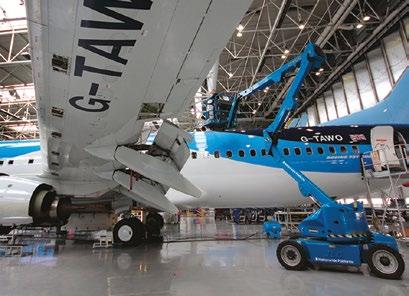
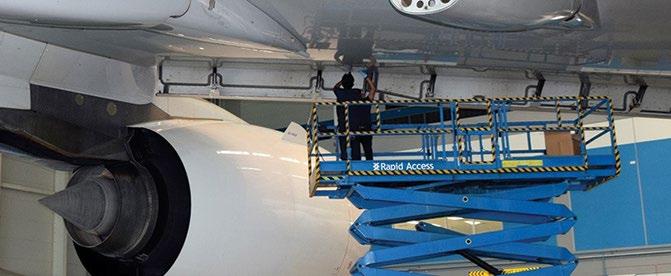
Commercial aviation is big business and ensuring aircraft are fully operational with minimal downtime is absolutely critical. keeping aircraft in the air means the ability to satisfy safety and maintenance requirements in as short a time as possible, which in turn has led to the development of improved, more efficient methods of working at height. These developments have enhanced speed and safety both for the highly trained engineers working on the planes but also in protecting the aircraft fuselages and engines from damage. As a result, access equipment specifically designed for the sector has expanded and grown to incorporate the latest technologies.
Until the advent of powered access equipment, the working at height platforms and methods had remained very similar, at least in concept terms, for the best part of 75 years including items such as mobile steps, ladders and purpose built staging - often designed for the specific aircraft type. Developments in aircraft design and requirements over the past 50 years or more has led to aircraft that are physically much larger resulting in tail section heights of more than 20 metres, making steps and ladders impracticable.
When the first self-propelled boom lifts came on the market in the late 1960s, the airlines were among the first customers, prior to that truck mounted lifts had also been used. In more recent times the improved working heights and finer controls has seen aerial work platforms transform the way routine checks and even basic repair and maintenance tasks are carried out. However, when it comes to major repairs and rebuilds aircraft specific staging remains the access method of choice, as it provides safe work at height access for teams of technicians reaching many areas at the same time to minimise the time the aircraft is in dock.
Semmco
One of the companies working in this area is Semmco, a family owned engineering company that designs, manufactures, installs and services a wide range of ground support equipment and aviation access platforms. Established in 1993, the company is based in Woking, UK, with offices in Texas and Dubai. The company not only supplies equipment to the airlines, but also works in sectors such as rail and the military.
It’s product range includes fixed and variable height steps, variable height access platforms and fixed and dual height re-fuelling steps. However, it also designs and builds bespoke solutions, such as a platform to reach the intricate nose avionics area of the Airbus A320 range of aircraft for Lufthansa Technik Puerto Rico.
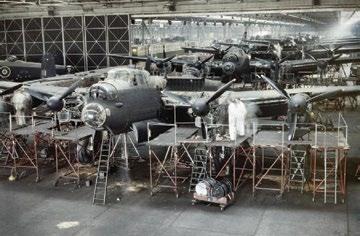
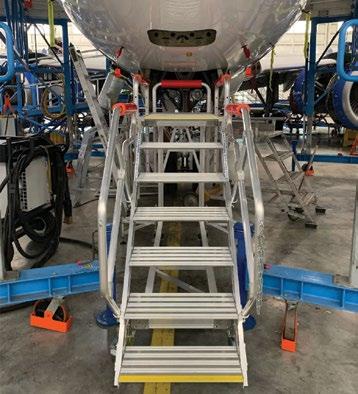
Nose job
Lufthansa Technik specialises in Maintenance, Repair and Overhaul (MRO) services, particularly on the Airbus A320 range. It is based in a 20,000 square metre facility at Rafael Hernández Airport in Aguadilla - known for being the longest airport runway in the Caribbean - and has around 300 highly qualified personnel performing in-depth maintenance and overhaul checks for both North and South American customers.
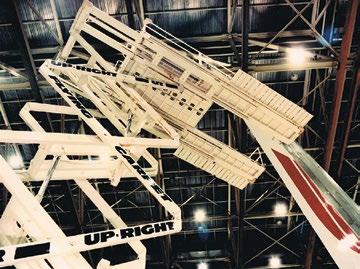
The company employs a variety of docking systems to gain crucial access to the aircraft nose, wings and tail, but an internal improvement drive identified the need for a standardised work platform to access the nose area. The new platform had to work within the constraints of the specialist docking systems and be adjustable so that it could be used with the aircraft on jacks or wheels. It was also important that the new platform didn’t take up too much space in the hangar - an issue with previous system.
The typical solution to such requirements is a variable height platform, however this was not what the customer wanted in this case. So, a simpler, fixed height platform was recommended, but with the addition of a hop-up for use when the aircraft was jacked. A key design element was the sliding handrails that provided the flexibility but maintained safety standards.
The new platform’s design and stability received positive feedback as it fitted neatly into the dedicated area. Minor design tweaks were advised, including an additional pin added to the handrails to ensure they would be permanently fixed to the platform in order to avoid parts going missing.
Chief executive Pat Foley said: “We are pleased with the quality of the final version of Semmco’s Avionics Access Stairs. Our priority is safety compliance and ensuring all team members performing aircraft maintenance, repair and overhaul can do so in a secure environment.”
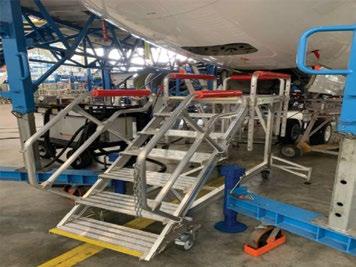
Planet Platforms
Another company offering bespoke aviation platforms is UK based Planet Platforms. “Powered access platforms are used extensively for aircraft maintenance as they offer a quick and safe way of working at height,” says the company. “However, as they are mobile, they bring the added risk of accidental aircraft damage. This was the main reason that one of our customers moved away from away from them towards a complete aircraft docking system, covering random/windscreen, fuselage, and wings and Tail dock. Once in place they provide a larger working area that can accommodate more personnel, tools, and aircraft components than a powered access platform.”

New flight training
One of Planet’s purpose built systems is being used by Affinity Aerospace which works with the UK’s Ministry of Defence maintaining three fleets of aircraft within the UK Military Flying Training System. One of these aircraft is the Embraer Phenom 100 based at RAF College Cranwell - an RAF Station in the heart of Lincolnshire which was set up as a Royal Navy Training Establishment in 1916, making it the world’s first Air Academy.
The Phenom accommodates two student pilots, a four student rear crew and an instructor and is the start of their fixed wing training that will see some student pilots eventually graduate onto much larger aircraft like the Airbus A400M.
Keeping the Phenom maintained is critical to the delivery of the training. Planet Platforms was approached to design, build and install a purpose built access system for it. The solution was to design port and starboard over wing platforms and a two level Tail dock system. Working down the side of the aircraft the over wing platforms provide access to the two Pratt and Whitney Canada turbofan engines, while the Tail dock gives complete access to the tail flight controls and avionics. Constructed in two halves, the individual sections can be used to gain upper access or joined when a more complete span is needed. Additionally, cut-out sections permit full rotation function tests for the rudder without the need of removing the dock.
Manufactured from lightweight aluminium box profile all three systems can be simply manoeuvred into place by two people, as the solutions are set on low rolling resistance, lockable castors.
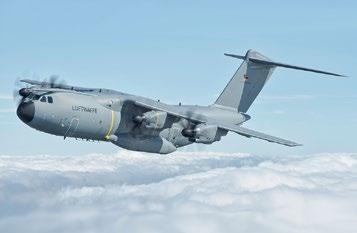

Powered access Solutions
Many if not most of the powered access manufacturers also offer ‘aviation’ packages to help prevent damage to the aircraft or other sensitive work surfaces. Genie’s Aircraft Protection Package for example uses foam padded auxiliary rails, located top and sides, plus padded proximity sensing rail underneath. It is available as a factory fit option on most of its larger booms although there are some limitations on the size of platform depending on the model.
Genie did produce the GS-2646AV scissor lift which it launched 10 years ago specifically aimed at aircraft manufacture and maintenance, however it is no longer available. Features included a powered platform extension which increased the deck length by an extra 1.5 metres and the Padded Aircraft Protection Rail system cushions on the platform guardrails preventing surface damage. Gates at both ends of the platform provide easy access for the operators and each incorporated a safety interlock, preventing the machine from being operated when they were open.
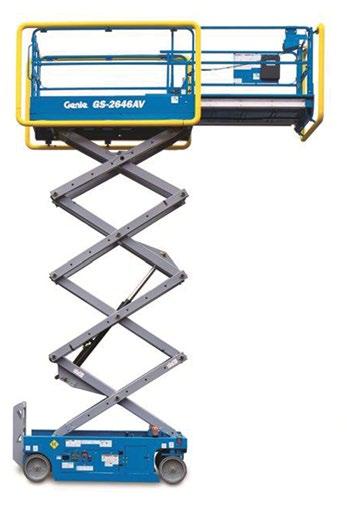
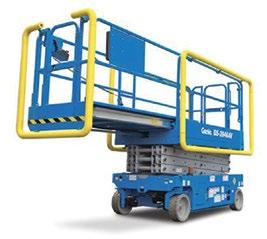
One thing manufacturers have found over the years is a disdain among many aviation maintenance engineers for a standard solution. Telling a company that “this is the way XYZ company carries out that work, and the solution is already designed” cuts no ice and can even generate a backlash such as “ well that would not be suitable for us”.
Bespoke design
Rapid Access, the Loxam group operation in the Middle East, won its first major aviation project at the Emirates airport in Dubai. The platforms were custom designed for the contract and included two specific safety solutions. One was the addition of Bump Guarding - pressure sensitive red strips around the edges of the platform.
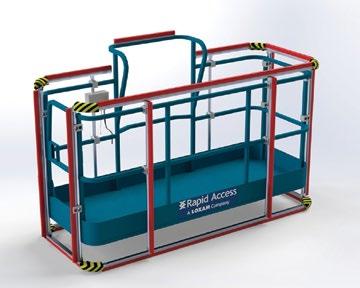
When any one of the strips makes the slightest contact, the system stops the machine from moving, preventing any damage to the plane. If it occurs the operator can then press an override button to move away from the object. The boom lifts fitted with the system were all Genie apart from two 125ft JLG 1250AJP. They included a 30ft Z30N electric with 1.2 metre basket, two 34ft Z34BE bi-energies with 1.5 metre baskets, seven 45ft Z45-25BE bi-energies, five 60ft Z60-37FE hybrids with 1.8 metre platforms plus four 125ft S125 XC with 2.4 metre.
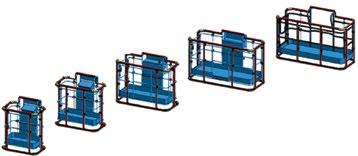
A second safety system installed on the scissor lifts use was the ‘Deck Aware’. A major cause of incidents involved operators lowering the scissor lift’s platform while the deck was still extended, hitting the plane below. Deck Aware prevents the down operation of the scissor until the deck has been retracted or the operator has function. The system was installed on a total of 69 Genie scissors including 19ft GS-1932, 32ft GS-3246 and 53ft GS-5390s.

NMP at Luton airport
Loxam’s second major aviation project was for TUI Airways at Luton airport in the UK, where Nationwide Platforms has 36 platforms on site from JLG, Skyjack and Niftylift. They include 13 slab electric scissor lifts, five hybrid booms and 16 electric mast type lifts.
All the machines are equipped with aircraft specific safety solutions to avoid damaging the aircraft and include electronic or soft-edge solutions. The machines are also equipped with full telematics system allowing the customer to restrict use to authorised operators, monitor machine usage - including last user - and machine location.
Nifty HR17N hybrid
TUI is using the 17 metre working height/9.7 metre outreach Nifty HR17N Hybrid to access the back of aircraft’s tail fins. Being contoured and at the highest point on the plane it makes them tricky to reach with a standard scissor lift. The boom’s compact dimensions and zero tail swing have proved ideal for work in the restricted space. The HR17N can be ordered with all-electric battery power or the second generation Hybrid power system. The Nifty HR17H has enough outreach to access the centre of the aircraft, although this is rarely needed and are fitted with Niftylift’s own factory-fit Aviation-pack.

All the other platforms are fitted with lagging and Bump Guarding supplied and fitted by the Nationwide Platforms depot. These include a 45ft JLG E450EJ electric boom lift used by the cleaning crew on the plane’s exterior which has a working height of 15.72 metre, 7.24 metre of outreach with 227kg unrestricted platform capacity.
The majority of the platforms - 16 of them - are Skyjack SJ12 self-propelled mast type lifts. They are also used by the cleaning crew to work, covering the lower level exterior surfaces as well as any repairs to wings, windows, doors and components.
There are 16 Skyjack scissor lifts - 10, 26ft SJ4726 and six 26ft SJ3226. The 1.19 metre wide SJ4726 are used mainly externally for airside applications and short maintenance tasks. The narrower SJ3226 scissors are used for general purpose cleaning, spraying, painting and plane repairs.
More than 80 percent of the platforms are on long term rental i.e., more than 12 months, with the remainder being spot hired throughout the year for situation specific requirements such as maintenance or the repair of wind damage to an aircraft.

Collision avoidance systems
The advancement in technology over the past decade has resulted in multiple safety/monitoring systems for boom lifts and scissor platforms. One such system is available from US based Bailey Speciality Cranes & Aerials, which as the name suggests designs and builds equipment for niche markets such as explosion proof scissors or boom lifts.
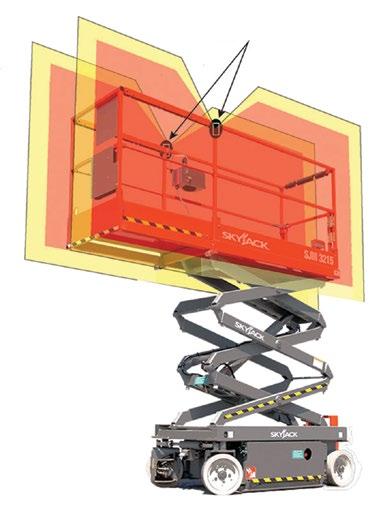
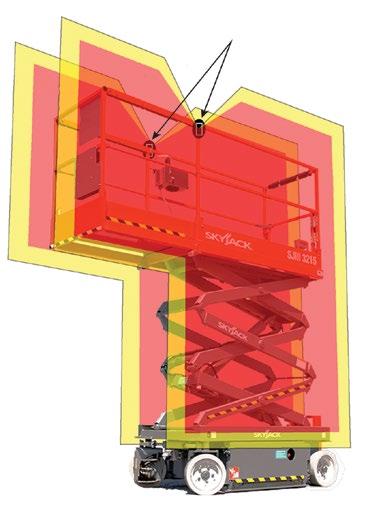
One of its products is its Collision Avoidance System available for booms and scissors. For scissors there are two systems - basic and advanced. The basic system uses two or four laser scanners mounted on the outer edges of the platform projecting down to scan both sides below and above. Depending on where the lasers are positioned the scanners move with the deck extension providing continued protection to the front of the platform. The lasers sense two safety zones - Red which is very close and Yellow which is slightly further away - which adjust automatically with the changing scissor lift height and platform extension.
When used on a boom lift, the two side lasers cover the sides, front and back, above and below.

The lasers - Eye Safe Laser Class with IP67 outdoor rating - detect metals or composites in the two zones, depending on how close the object is. When in the Yellow zone it initiates and alarm and puts the machine into auto creep speed. In the Red zone it automatically stops the machine even when driving at full speed in order to prevent a collision. Once an object has been detected the operator pushes an override button to restore the machines functions. ■











